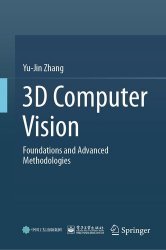3D Computer Vision: Foundations and Advanced Methodologies
- Добавил: literator
- Дата: 30-04-2024, 04:14
- Комментариев: 0
 Название: 3D Computer Vision: Foundations and Advanced Methodologies
Название: 3D Computer Vision: Foundations and Advanced MethodologiesАвтор: Yu-Jin Zhang
Издательство: Springer/Publishing House of Electronics Industry
Год: 2024
Страниц: 479
Язык: английский
Формат: pdf
Размер: 10.9 MB
This book offers a comprehensive and unbiased introduction to 3D Computer Vision, ranging from its foundations and essential principles to advanced methodologies and technologies. Divided into 11 chapters, it covers the main workflow of 3D computer vision as follows: camera imaging and calibration models; various modes and means of 3D image acquisition; binocular, trinocular and multi-ocular stereo vision matching techniques; monocular single-image and multi-image scene restoration methods; point cloud data processing and modeling; simultaneous location and mapping; generalized image and scene matching; and understanding spatial-temporal behavior.
Computer Vision is the use of computers to realize human visual functions, that is, the sensation, perception, processing, and interpretation of three-dimensional scenes in the objective world. The original purpose of vision research is to grasp and understand the image of the scene; identify and locate the objects in it; determine their own structure, spatial arrangement, and distribution; and explain the relationship between objects. The research goal of computer vision is to make meaningful judgments about actual objects and scenes in the objective world based on perceived images.
Each topic is addressed in a uniform manner: the dedicated chapter first covers the essential concepts and basic principles before presenting a selection of typical, specific methods and practical techniques. In turn, it introduces readers to the most important recent developments, especially in the last three years. This approachallows them to quickly familiarize themselves with the subject, implement the techniques discussed, and design or improve their own methods for specific applications. The book can be used as a textbook for graduate courses in Computer Science, computer engineering, electrical engineering, Data Science, and related subjects. It also offers a valuable reference guide for researchers and practitioners alike.
Deep Learning uses cascaded multilayer nonlinear processing units for feature extraction and transformation, realizing multilevel feature representation and concept abstraction learning. Deep Learning still belongs to the category of Machine Learning, but compared with traditional machine learning methods, Deep Learning methods avoid the requirements for manual design features under traditional Machine Learning methods and show obvious effect advantages under big data. Compared with traditional Machine Learning methods, Deep Learning is more general and requires less prior knowledge and annotation data. However, the theoretical framework of Deep Learning has not been fully established. At present, there is still a lack of powerful and complete theoretical explanation for how deep neural network operates and why it has high performance.
This book focuses on the fundamentals and recent advances in Computer Vision. In the 10 chapters introducing computer vision technology, the basic concepts and basic principles of the technology are first described, and the typical methods for implementing the technology are analyzed in detail (including algorithm description, specific steps, effect examples, etc.), and some new developments in the field of technology are introduced, summarized, and classified, which can help readers understand the latest development trends.
Скачать 3D Computer Vision: Foundations and Advanced Methodologies
Внимание
Уважаемый посетитель, Вы зашли на сайт как незарегистрированный пользователь.
Мы рекомендуем Вам зарегистрироваться либо войти на сайт под своим именем.
Уважаемый посетитель, Вы зашли на сайт как незарегистрированный пользователь.
Мы рекомендуем Вам зарегистрироваться либо войти на сайт под своим именем.
Информация
Посетители, находящиеся в группе Гости, не могут оставлять комментарии к данной публикации.
Посетители, находящиеся в группе Гости, не могут оставлять комментарии к данной публикации.
